Amazon.com, Inc appeared to be trading more than 94 percent lower in the premarket, but the new $125 price tag on the stock is due to a 20-1 stock split, which took effect on Monday after being announced in March.
The stock split prompted analysts to adjust their price targets on Amazon, with Morgan Stanley maintaining its Overweight rating and adjusting the price target to $175 and MKM Partners maintaining its Buy rating on the stock and adjusting the price target to $180.





